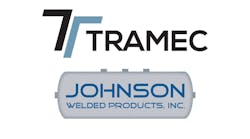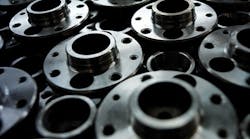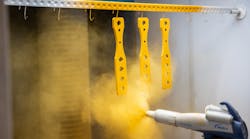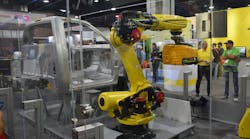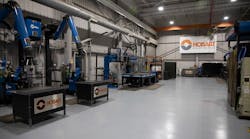GAS metal arc welding (GMAW) was originally developed in the 1940s for welding aluminum and other non-ferrous materials. But because of faster welding time, it was applied to steel. And now it is the most common industrial welding process.
The American Welding society defines GMAW as arc welding using a continuously fed consumable electrode and a shielding gas. It is also known as MIG (metal inert gas),
“It’s not actually the proper term,” said Scott Wright, technical resource manager and certified welding supervisor for Miller Electric, “because MIG stands for metal inert gas, and aluminum welding is that, but for everything else we do, we’re using active gas. We’re not using just an inert gas.”
Wright listed the advantages of GMAW:
• Uses a continuous electrode.
• Can be used on all weldable metals.
• Easy to learn. “Approximately 85% of the cost in North America to put down a weld is labor, so because this process is easier to learn and there is a high deposition rate and travel speed, it is something we like to use in the manufacturing environment.”
• Requires fewer stops and starts.
• Produces clean, slag-free welds.
• Can be used in all positions. “We can do some different things with the arc.”
Wright said the applications include metal fabrication, manufacturing, maintenance, home hobbyist, and repair.
The modes of transfer:
• Short circuit transfer (also known as GMAWS or short arc dip transfer).
Advantages/applications: thin material; out-of-position work; open root; poor fit-up; and materials less than 3/16” thick.
Limitations: Production of some spatter; lack of penetration on thicker materials; and limited use on aluminum.
• Globular transfer.
Generally not recommended because it has a high amount of spatter and there’s potential for incomplete penetration.
• Spray transfer (90%Argon – 10% Co2 is recommended).
Advantages: high deposition; good bead appearance; capability of using large-diameter wires; the presence of very little if any spatter; and good fusion and penetration.
Limitations: used only on material 1/8” inch or thicker; good fit-up is always required because there is no open root capability; and can only be used in flat or horizontal position.
• Pulse spray transfer.
“The equipment has the ability to pulse the arc between a peak amperage and voltage and a background amperage and voltage,” Wright said. “When the wire is at the peak amperage and voltage, it is hot enough at full spray and transfers filler metals across the arc. When it’s in the background, the arc stays established so we still have a spray, but it is cool enough that the puddle cools and it does not transfer filler metal across the arc.”
Advantages: all position welding; the background current allows the puddle to cool slightly; no spatter; thin or thick metals; flexibility and productivity; and programmable.
“Some other advantages are that it helps minimize distortion because as that puddle is cooling in the background and you’re moving faster, both of those work together to reduce heat,” he said. “So it helps with lot of distortion problems. Most of machines and equipment today that manufacturers build today are adaptive to change. Older equipment wasn’t. If a guy didn’t hold it right in there, his arc would change.
“Pulse spray transfer also helps remove impurities better than even a pulse spray. It also actually reduces fume generation. That pulsing action can get rid of fumes. That’s sometimes something we don’t think about.”
Limitations:
• Additional cost of equipment. “Equipment is usually a bit more expensive. It can be marginal but is more expensive. It does a whole lot more.”
• Operator acceptance and knowledge of the process. “It’s not quite as bad today as it once was because the equipment actually helps the operator more than it did, but it does take some training. It does have a different sound. Some guys just can’t get over that sound being so much different. It has that bumblebee sound.”
• Difficulty in setting parameters. “In today’s equipment, we take the guesswork out of it. A large portion of manufacturers let you dial in the wire size you’re running, wire type, gas combination, and now we use the term ‘synergically.’ Synergically, it will pull everything up together and everything down together.”
• Open root and poor fit-up. “We call it a limitation. However, it can do a lot more than a regular spray can. It can potentially resolve issues where somebody doesn’t really want to use a short arc.”
Selecting the right shielding gas
Talking about shielding gases, he said 100% CO2 and 75% Argon/25% CO2 are not recommended for spray transfer and pulse spray transfer and deviations.
Wright said 90%Argon/10% CO2 will help produce a spray transfer when welding on steel with GMAW.
GMAW variables: stick out; electrode extension; arc length; nozzle-to-work distance; contact tip to work distance; and contact tip setback.
He said that as contact-tip-to-work distance (CTWD) or electrode extension increases, the welding current or amperage decreases. The amperage rule of thumb is one ampere for every .001” of material. One-eighth inch of material equals .125 equals 125 amps.
How to determine the correct size wire:
• Determine the ballpark amperage for the material you are welding using the rule of thumb.
• Reference the manufacturer’s wire data sheet. The wire data sheet has an amperage range for each wire size.
• Choose a wire size. Your ballpark range should fall near the middle of one of the amperage ranges on the wire diameter chart.
Determining wire-feed speed (WFS):
• WFS has a direct effect on amperage. Increasing or decreasing the wire feed speed changes the current and amperage.
• Once wire size and amperage have been determined, the correct WFS needs to be determined. Use this rule of thumb: inches per minute needed per amp. For example, a steel wire size of .023” means 3.5 WFS is needed per amp.
Wright said deposition rate is the amount of weld metal that can be deposited into the weld.
“It is the key factor in producing weld efficiently,” Wright said. “Factors that lower the deposition rate include spatter—incorrect amperage—and transfer modes.
The impacts of voltage
Wright said voltage has a direct effect on the height and width of the bead. It is directly proportional to arc length; increasing voltage will increase the arc length. GMAW machines are most often CV machines, meaning arc length is maintained and there is consistent energy.
Wright said inductance only affects the initial short that occurs when starting the arc.
“It acts like a shock absorber,” he said. “Inductance slows the response of the machine to raise and lower the amperage. It creates a slightly longer arc ‘on’ time.
“Adding inductance decreases the number of shorts/second. When on, inductance spreads out the deposited metal—a wetter, more fluid arc. Too much means it’s hard to start the arc. Not enough means a harsh/spattery arc. The optimum is clean starts and minimum spatter.”
Wright said incorrect travel speeds can cause discontinuities and rejectable welds.
“Travel speeds affect penetration and weld bead shape,” he said. “Too fast means there’s not as much heat/inch of weld, it reduces the melting of the base metal, there’s less penetration, a taller, less wide bead, and undercutting at the toes. Too slow means limited penetration, the arc is dwelling on top of the puddle, and the net result is a wider bead.” ♦
For more information on National Association of Trailer Manufacturers
check out NATM.com.
